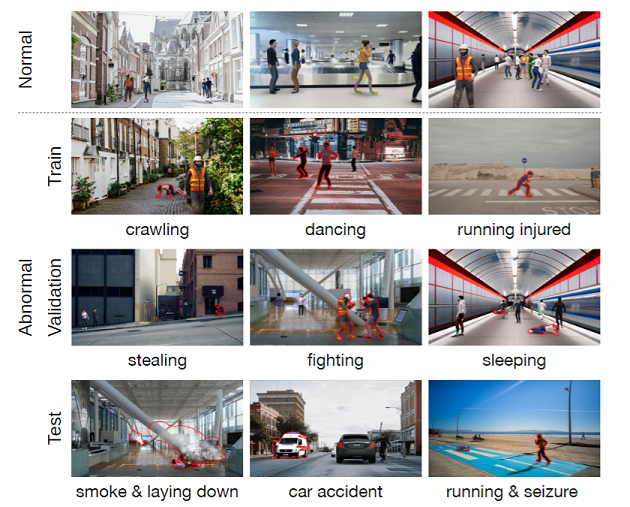Andra Acsintoae*, Andrei Florescu*, Mariana-Iuliana Georgescu*, Tudor Mare*, Paul Sumedrea*, Radu Tudor Ionescu, Fahad Shahbaz Khan, Mubarak Shah
*equal contribution
IEEE/CVF Conference on Computer Vision and Pattern Recognition (CVPR), 2022.
ArXiv URL: https://arxiv.org/pdf/2111.08644.pdf
We present an abnormal video in the left side (the anomalous regions are emphasised with red contour) while in the right side we present a normal video from the UBnormal data set.
UBnormal is a new supervised open-set benchmark composed of multiple virtual scenes for video anomaly detection. Unlike existing data sets, we introduce abnormal events annotated at the pixel level at training time, for the first time enabling the use of fully-supervised learning methods for abnormal event detection. To preserve the typical open-set formulation, we make sure to include disjoint sets of anomaly types in our training and test collections of videos.
Examples of actions from our data set:

The UBnormal data set can be downloaded from here.
The results on the UBnormal data set on the test set:
| Method | Micro-AUC | Macro-AUC | RBDC | TBDC |
| Georgescu et al. [1] + UBnormal anomalies | 61.3 | 85.6 | 25.430 | 56.272 |
| Sultani et al. [2] (fine-tuned) | 50.3 | 76.8 | 0.002 | 0.001 |
| Bertasius et al. [3] (1/32 sample rate, fine-tuned) | 68.5 | 80.3 | 0.041 | 0.053 |
The split of the data set is in scripts. See the scripts folder for more details.
The present data set is released under the Attribution-NonCommercial-NoDerivatives 4.0 International (CC BY-NC-ND 4.0) license.
Please cite our work if you use any material released in this repository.
@InProceedings{Acsintoae_CVPR_2022,
author = {Andra Acsintoae and Andrei Florescu and Mariana{-}Iuliana Georgescu and Tudor Mare and Paul Sumedrea and Radu Tudor Ionescu and Fahad Shahbaz Khan and Mubarak Shah},
title = {UBnormal: New Benchmark for Supervised Open-Set Video Anomaly Detection},
booktitle = {Proceedings of the IEEE/CVF Conference on Computer Vision and Pattern Recognition (CVPR)},
month = {June},
year = {2022},
}


